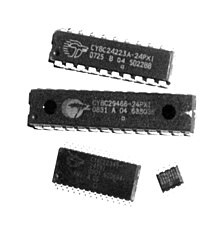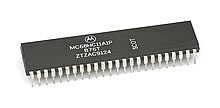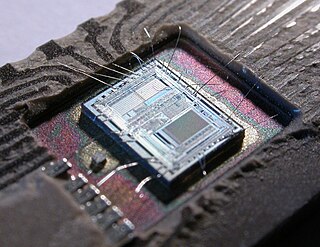
A microcontroller or microcontroller unit (MCU) is a small computer on a single integrated circuit. A microcontroller contains one or more CPUs along with memory and programmable input/output peripherals. Program memory in the form of NOR flash, OTP ROM, or ferroelectric RAM is also often included on the chip, as well as a small amount of RAM. Microcontrollers are designed for embedded applications, in contrast to the microprocessors used in personal computers or other general-purpose applications consisting of various discrete chips.
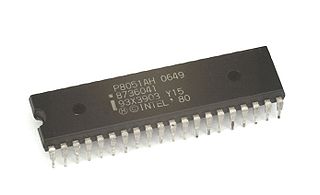
The Intel MCS-51 is a single chip microcontroller (MCU) series developed by Intel in 1980 for use in embedded systems. The architect of the Intel MCS-51 instruction set was John H. Wharton. Intel's original versions were popular in the 1980s and early 1990s, and enhanced binary compatible derivatives remain popular today. It is a complex instruction set computer, but also has some of the features of RISC architectures, such as a large register set and register windows, and has separate memory spaces for program instructions and data.

AVR is a family of microcontrollers developed since 1996 by Atmel, acquired by Microchip Technology in 2016. These are modified Harvard architecture 8-bit RISC single-chip microcontrollers. AVR was one of the first microcontroller families to use on-chip flash memory for program storage, as opposed to one-time programmable ROM, EPROM, or EEPROM used by other microcontrollers at the time.
Atmel Corporation was a creator and manufacturer of semiconductors before being subsumed by Microchip Technology in 2016. Atmel was founded in 1984. The company focused on embedded systems built around microcontrollers. Its products included microcontrollers radio-frequency (RF) devices including Wi-Fi, EEPROM, and flash memory devices, symmetric and asymmetric security chips, touch sensors and controllers, and application-specific products. Atmel supplies its devices as standard products, application-specific integrated circuits (ASICs), or application-specific standard product (ASSPs) depending on the requirements of its customers.

PIC is a family of microcontrollers made by Microchip Technology, derived from the PIC1640 originally developed by General Instrument's Microelectronics Division. The name PIC initially referred to Peripheral Interface Controller, and is currently expanded as Programmable Intelligent Computer. The first parts of the family were available in 1976; by 2013 the company had shipped more than twelve billion individual parts, used in a wide variety of embedded systems.
Atmel ARM-based processors are microcontrollers and microprocessors integrated circuits, by Microchip Technology, that are based on various 32-bit ARM processor cores, with in-house designed peripherals and tool support.
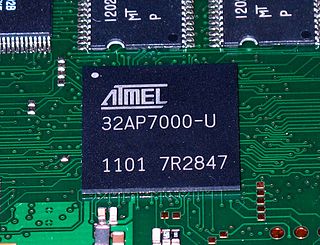
AVR32 is a 32-bit RISC microcontroller architecture produced by Atmel. The microcontroller architecture was designed by a handful of people educated at the Norwegian University of Science and Technology, including lead designer Øyvind Strøm and CPU architect Erik Renno in Atmel's Norwegian design center.
ARM9 is a group of 32-bit RISC ARM processor cores licensed by ARM Holdings for microcontroller use. The ARM9 core family consists of ARM9TDMI, ARM940T, ARM9E-S, ARM966E-S, ARM920T, ARM922T, ARM946E-S, ARM9EJ-S, ARM926EJ-S, ARM968E-S, ARM996HS. ARM9 cores were released from 1998 to 2006 and they are no longer recommended for new IC designs; recommended alternatives include ARM Cortex-A, ARM Cortex-M, and ARM Cortex-R cores.

PSoC is a family of microcontroller integrated circuits by Cypress Semiconductor. These chips include a CPU core and mixed-signal arrays of configurable integrated analog and digital peripherals.

Holtek Semiconductor is a Taiwan-based semiconductor design centre and provider with its headquarters and design operations based in the Hsinchu Science Park in Taiwan, and has sales offices located the United States and India. Holtek's design focus is in both 32-bit and 8-bit along with Touch microcontroller development, and as of 2022 the firm employed 631 employees. Holtek also designs and provides peripheral semiconductor products such as remote control, telecommunication, power management, computer peripheral, and memory devices. Holtek's device application area is concentrated in the consumer product field such as household appliances, computer peripheral products, remote controllers, leisure products, medical equipment as well as industrial controllers. Holtek microcontrollers are in home appliances including brands such as Philips, Siemens, Märklin and Japanese brands such as Futaba and Sony.
EFM32 Gecko MCUs are a family of mixed-signal 32-bit microcontroller integrated circuits from Energy Micro based on ARM Cortex-M CPUs, including the Cortex-M0+, Cortex-M3, and Cortex-M4.

The ARM Cortex-M is a group of 32-bit RISC ARM processor cores licensed by ARM Limited. These cores are optimized for low-cost and energy-efficient integrated circuits, which have been embedded in tens of billions of consumer devices. Though they are most often the main component of microcontroller chips, sometimes they are embedded inside other types of chips too. The Cortex-M family consists of Cortex-M0, Cortex-M0+, Cortex-M1, Cortex-M3, Cortex-M4, Cortex-M7, Cortex-M23, Cortex-M33, Cortex-M35P, Cortex-M52, Cortex-M55, Cortex-M85. A floating-point unit (FPU) option is available for Cortex-M4 / M7 / M33 / M35P / M52 / M55 / M85 cores, and when included in the silicon these cores are sometimes known as "Cortex-MxF", where 'x' is the core variant.
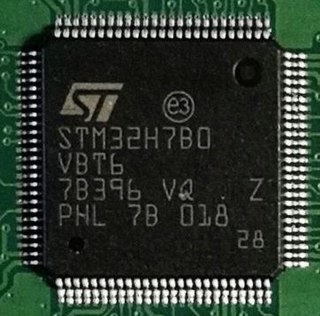
STM32 is a family of 32-bit microcontroller integrated circuits by STMicroelectronics. The STM32 chips are grouped into related series that are based around the same 32-bit ARM processor core: Cortex-M0, Cortex-M0+, Cortex-M3, Cortex-M4, Cortex-M7, Cortex-M33. Internally, each microcontroller consists of ARM processor core(s), flash memory, static RAM, debugging interface, and various peripherals.
XMC is a family of microcontroller ICs by Infineon. The XMC microcontrollers use the 32-bit RISC ARM processor cores from ARM Holdings, such as Cortex-M4F and Cortex-M0. XMC stands for "cross-market microcontrollers", meaning that this family can cover due to compatibility and configuration options, a wide range in industrial applications. The family supports three essential trends in the industry: It increases the energy efficiency of the systems, supports a variety of communication standards and reduces software complexity in the development of the application's software environment with the parallel released eclipse-based software tool DAVE.

LPC is a family of 32-bit microcontroller integrated circuits by NXP Semiconductors. The LPC chips are grouped into related series that are based around the same 32-bit ARM processor core, such as the Cortex-M4F, Cortex-M3, Cortex-M0+, or Cortex-M0. Internally, each microcontroller consists of the processor core, static RAM memory, flash memory, debugging interface, and various peripherals. The earliest LPC series were based on the Intel 8-bit 80C51 core. As of February 2011, NXP had shipped over one billion ARM processor-based chips.
GigaDevice Semiconductor is a Chinese NOR flash memory designer. It also produces microcontrollers, some of them are based on the ARM architecture, and other on the RISC-V architecture.

78K is the trademark name of 16- and 8-bit microcontroller family manufactured by Renesas Electronics, originally developed by NEC started in 1986. The basis of 78K Family is an accumulator-based register-bank CISC architecture. 78K is a single-chip microcontroller, which usually integrates; program ROM, data RAM, serial interfaces, timers, I/O ports, an A/D converter, an interrupt controller, and a CPU core, on one die.
In computing, autonomous peripheral operation is a hardware feature found in some microcontroller architectures to off-load certain tasks into embedded autonomous peripherals in order to minimize latencies and improve throughput in hard real-time applications as well as to save energy in ultra-low-power designs.

RP2040 is a 32-bit dual ARM Cortex-M0+ microcontroller integrated circuit by Raspberry Pi Ltd. In January 2021, it was released as part of the Raspberry Pi Pico board. Its successor is the RP2350 series.

